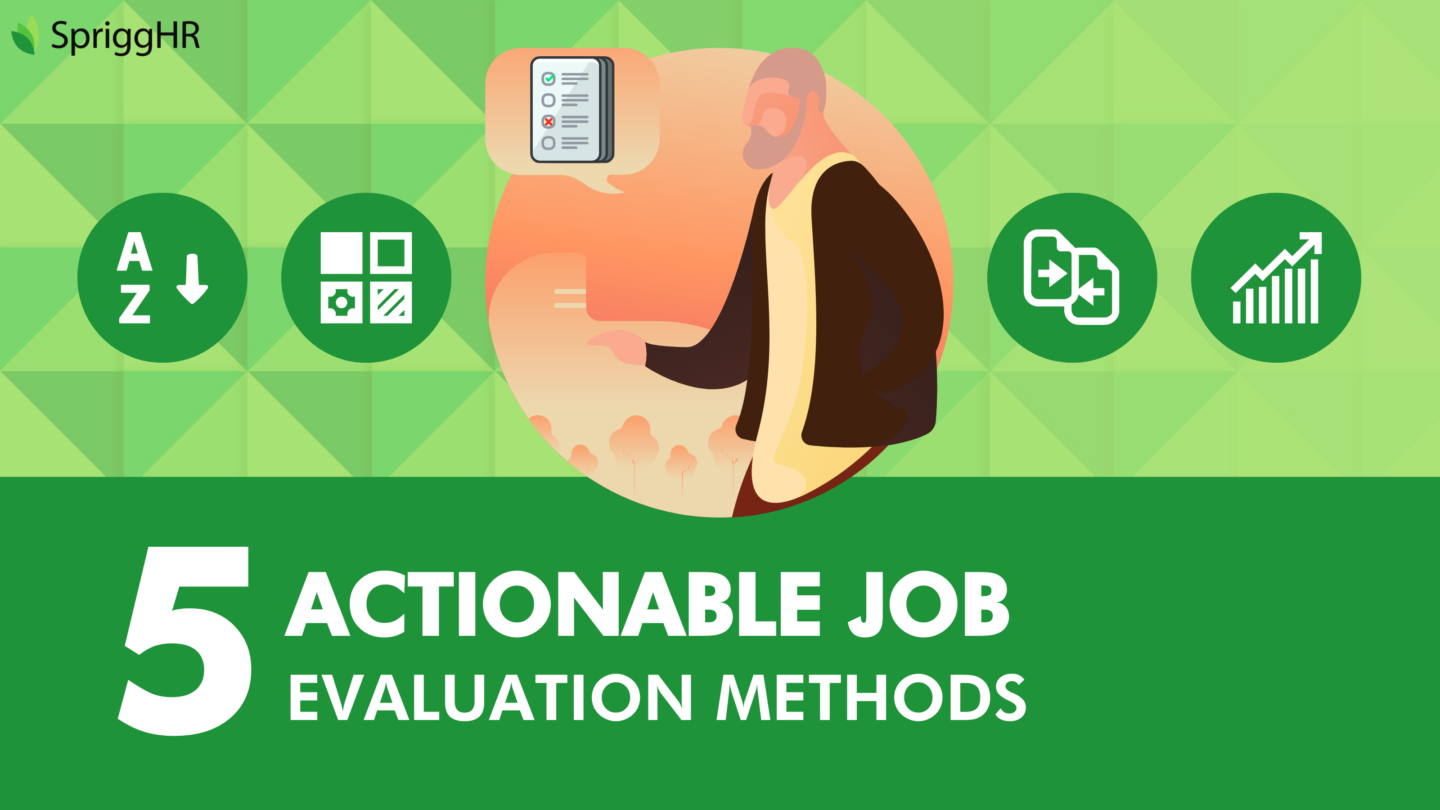
5 Actionable Job Evaluation Methods
What is Job Evaluation?
Job evaluation refers to a systematic method of determining a given job’s relative value or worth in relation to other jobs within a specific organization. Its primary goal is to produce a systematic comparison between jobs in order to assess their relative worth, usually for the purpose of establishing a rational pay structure.
Why is Job Evaluation Used?
Effective job evaluation methods can produce several managerial benefits for an organization. The primary reasons for implementing a job evaluation system include:
Determining what positions and jobs within an organization are similar.
This assessment of similarity can be useful when determining pay, promotions, lateral moves, transfers, assignments and assigned work projects, and even internal party issues. It is important for all employees to perceive their workplace as a fair and equitable place, as well as a provider for equal opportunities for all employees. This means that the process for determining pay and promotional opportunities should remain transparent.
Determining appropriate pay, salary grades, and other compensation issues.
Compensation is undoubtedly a significant factor in employee satisfaction in the workplace. Public employee pay is posted publicly, and employees discussing their pay amongst each other is unavoidable. This means that should there be compensation inequities in your company pay system, word will travel quickly. Effective job evaluation aims to remedy the potential of this occurring by fairly evaluating the value of all jobs equitably.
Helping in the development of job descriptions and specifications, performance standards, competencies, and a performance appraisal system.
Particularly in larger companies, though required in all forms of an organization, all these factors must be equitable and not dependent on managers or departmental whims. Employees will always compare notes, especially in terms of what is expected of them. When an employer keeps this in mind as they develop their employee systems, they are bound to win employee loyalty and commitment.
Assisting with employee career paths, planning, or pathing, as well as succession or promotional planning.
Employees highly value having a clear, well-defined career path and appreciate tangible opportunities for growth and development. Often, an employee’s decision to leave one company for another hinges upon a better opportunity for them, which could take shape either in a promotion or a new position where they perceive they have more potential for advancement. Effective job evaluation takes this into consideration and outlines the responsibilities of each job with long-term succession planning in mind.
Assisting the employee recruitment process.
This is most often done so by setting in place specific job responsibilities that will help with:
- The development of job postings
- The assessment of applicant qualifications
- Suitable compensation
- Salary negotiations
- Having a benchmark for fair market value
When is Job Evaluation Used?
Particularly in larger organizations, job evaluation is a moving target. Many factors can cause an employee’s job classification to change, including but not limited to:
- Adopting new technology
- Employees taking on additional responsibilities
- Downsizing and layoffs
- New programs and procedures
- Increased authority over projects or persons
- Team leader or supervisory responsibilities
While job evaluation should be a regular occurrence within your organization, especially if it regularly seeks to address the variables listed above, job analysis and evaluation usually occurs when a brand-new position is created. It is also often used each time a particularly significant change occurs in a job. In job evaluations that result in decisions about a job’s classification in an organization, many factors are compared. Those that are primarily considered are the decision-making authority, scope, and range of the responsibilities performed, the level of the duties performed, and the relationship of the position to other jobs within the organization.
Should an employee seek out a job classification re-evaluation, they typically request it through their employer and are then through formal process, re-assessed. The most common request for these occurs when an employee has taken on new responsibilities or has a significantly increased workload. More work does not always equal a change in scope, range, decision-making authority, or a higher level of responsibility. In these cases, the job evaluation process would result in a classification that remains the same until the next due assessment.
5 Actionable Job Evaluation Methods
1. Ranking Method
This method ranks jobs in order based on each position’s perceived value in relation to others. Although this method does not consider market compensation rates, it may work well for smaller companies. Larger companies employing this method could be complex due to the larger number of positions, but could still work if jobs are grouped, for example by professional level.
2. Classification/Grading Method
In this job evaluation method, generic job characteristics are grouped together to reflect their level of skill and responsibility at several predetermined grade classifications. This method tends to be straightforward and not as time-consuming as some others.
For this, individual jobs are compared to groups of pre-determined job characteristics, and then matched to a specific grade classification based on the comparison. This can pose some challenges, as one set of characteristics will not always fit every job within an organization. This system is also subject to grade inflation as jobs proceed to higher levels, which could lead to ineffective evaluations.
3. Point-Factor Method
This method identifies specific job factors that add value and worth to a position. These factors are separated into groups such as skill, responsibility, and effort, and are then assigned a numerical or weighted point value. Points for individual factors that a specific job meets are added up to get a point value for the job as a whole. The downsides to this method are that the point values may not always reflect market values of jobs, and the system also poses the risk of generating an internal hierarchy.
4. Factor Comparison Method
Like the Point-Factor Method, this strategy has job factors identified under primary groups, and each factor is assigned a dollar value as opposed to a point value. As this tends to be more complex, only a few organizations employ this method. It can also be hard to communicate to employees, and there is an inherent degree of subjectivity involved in the determination of the dollar values.
5. Competitive Market Analysis Method
This job evaluation method uses external data to inform decision about a job’s relative value in an organization. As job evaluations form the basis for market pricing, this method aims to utilize posted job descriptions to compare jobs to like positions in the external marketplace. Specific pay data is collected from published sources, and the value of the position within the competitive market is determined based on this data.
An integral component of this method is the consideration of the organization’s compensation philosophy, posing the question of, “Where do we want to position ourselves within the job market?”. As this job evaluation method involves examining internal value against public market data, employers are required to use an overlay to see how rankings fit within the internal hierarchy of their organization.
Final Thoughts
Job evaluation methods are deliberate attempts used by organizations to structure both the technical and social aspects of a job, in order to attain a healthy fit between the job holder and the job itself. Its primary goal is to produce a systematic and equitable means to determine a job’s overall worth, which lends itself to an increase in employee satisfaction. By harnessing the potential of all jobs and job holders efficiently, the overall quality of an employee’s work life is enhanced, thereby improving employee performance overall.






